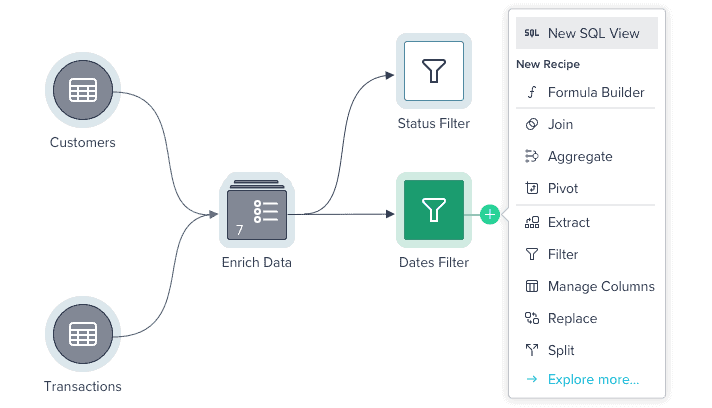What is a Semantic Layer?
- Justin Reynolds
- September 28, 2022

If you’re reading this, you may have heard the word “Semantic Layer” a couple of times before now and maybe are still unclear about what it means.
In this article, we aim to unravel the enigma behind semantic layers, outline some of its use cases and benefits, and share insight into how you can get started deploying your self-service semantic layer within Snowflake.
What Is A Semantic Layer: A Definition?
A semantic layer is a business representation of data. It enables end-users to quickly discover and access data using standard search terms — like a customer , recent purchase , and prospect . It also provides human-readable terms to data sources that otherwise would be impossible to discover (e.g., table slsqtq121 becomes Sales West 1st Quarter 2021).
Enterprises have multiple options to deploy a semantic layer on top of a data warehouse, which we’ll examine later in this piece. Once they’ve picked a solution, the organization will embed various abstractions — or virtualizations that enable end-users to make sense of source data — into the semantic layer to define business terms.
This helps reduces complexity while providing a framework for user reporting objects.
The Benefits of a Semantic Layer
Organizations across all verticals struggle to manage and access all the data they control. Nearly three-quarters of data never get used or analyzed.
One of the reasons for this is the gap that exists between data sources and business users.
Due to the decentralized data landscape in most companies, data silos tend to occur, leaving gaps in the “data-driven approach” and business users without any common or unified definitions.
Progressive companies opt for a more unified approach by deploying centralized data warehouses and leveraging semantic layers to help bridge this gap.
Here are 5 key benefits of leveraging semantic layers within your organization:
Enhanced Collaboration
Semantic layers remove complexity from identifying, analyzing, and reporting on data.
With a robust semantic layer, IT and business user teams can work parallel to yield optimal results.
By providing a semantic layer, business users can answer business questions easier.
This aids your resource in spending time doing the job they were hired for.

Improved Security and Governance
One of the biggest problems with data is accessibility and security. It can go in both directions. If you add too much security , analysts won’t be able to do their jobs and will try to bypass security rules and make multiple copies of data — which, in turn, compromises the integrity of their data. Add little to no security, and the enterprise will be compromised.
A semantic layer strikes the perfect balance between the extremes. Users can make changes to the data at a logical level, so data admins don’t have to worry about users corrupting data sources.

Self-service Reporting
Organizations today generate data in multiple shapes and sizes, storing that data in different repositories — like AWS S3 buckets and Microsoft ADLS.
Without a semantic layer, users need to create IT tickets to request an engineer to get the data for them, or they can waste time trying to become a data architect to obtain the data themselves.
There are huge risks associated with this approach. The process is slow, costly, and often provides inconsistent results. What’s more, due to the myriad of BI tools on the market, the fact that each tool tried to provide its own semantic layer, and how every tool had its own way of establishing business rules, every tool would produce different results — creating chaos while forcing users to spend more time trying to figure out which tool was right instead of gaining value from the data and acting on it.
With a semantic layer, business users get the peace of mind that comes with knowing they are generating reports from consistent data sources and a central source of truth.
Organizations can keep data clean, standardized, and secured with a semantic layer in place.

Reduce Data Latency
Some data has a shelf life and can become stale or worthless if it’s not used quickly. This is especially important in IoT environments, such as manufacturing and logistics.
A semantic layer accelerates time to insight and provides consistent results and secure data access while eliminating the need for complex data pipelines — which, in turn, allows businesses to gain value from all of their data faster.
Semantic Layer Use Cases
There are many ways organizations use semantic layers today. Here are three examples of how businesses can deploy semantic layers to streamline reporting, secure data, and enhance team collaboration.
Healthcare
With easy access to all relevant data, analysts can use semantic layers to predict patients whose conditions might be deteriorating in healthcare facilities and then rapidly reassign more healthcare resources to that individual to improve health outcomes.
Travel
When it comes to traveling, one of the most significant customer pain points is finding the best airfare price. With easy access to data, travel companies can build price forecasting tools that guess when the “best price” is available and automatically notify their customers of the deal, driving more sales.
Retail
A semantic layer enables retailers to consolidate all of their data, pulling it from POS systems, online stores, customer service touchpoints, and marketing programs altogether in one place. They can create data-driven campaigns and experiences that meet customer expectations.
Datameer – Your Universal Self-Service Semantic Layer For Snowflake
A universal semantic layer is a platform that can reduce complexity, improve security, and streamline reporting in complex environments.
At the same time, it provides all stakeholders access to clean and actionable data across any business intelligence tool.
Datameer , a SaaS Data Transformation, is one such tool.

With tools like Datameer, you can collaboratively transform and model your snowflake data.
With its multi-persona self-service UI, your team can collaborate using low-code,no-code (for business users), and code(data analysts) features.
Datameer offers a rich semantic layer for users, i.e., catalog-like data documentation and knowledge sharing to facilitate trust in the data and crowd-sourced data governance.
The system also auto-generates detailed meta-data, properties, and documentation.
Feel free to check out our demos to get up to speed on ways to leverage self-service semantic-layering using Datameer effectively.


